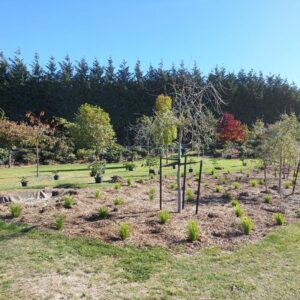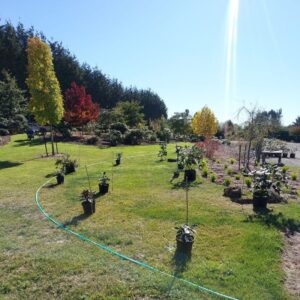July is the perfect time to start planning your next gardening venture. Here’s our tried-and-true method for preparing new flower beds:
Steve and I often get inspiration from other people’s gardens and browsing Pinterest. Once I gather ideas, I have to persuade Steve that another garden bed is necessary. We head outside with a hose and electric fence standards to outline lines and curves for the new bed. Using a hose helps us achieve the natural shapes we desire, providing a clear edge for spading in the future.
Once the new garden bed area has been decided on we focus on smothering the competition. To suppress weeds and grass, we cover the area with cardboard or newspaper. We then apply layers of compost, manure, and mulch. This layering process conditions the soil, encourages worm activity, and continues to suppress weeds as the season progresses.
When planning a new rhododendron bed, we always consider the hot afternoon western summer sun, as it’s the hottest in Canterbury. It’s crucial to determine which rhododendrons can handle the intense heat and which ones will thrive better in dappled shade. Rhododendrons flourish in areas with filtered light, so we carefully select trees that can provide that canopy effect in the summer while also being tolerant of wind. Tree placement is always our first consideration, followed by the understory of rhododendrons and other perennials.
- Spring is here at the nursery garden
- Using curves to create more depth. Always check final arrangement from different vantage points.
People often ask me what plants I put with Rhododendrons. As rhododendrons are such shallow-rooted plants, the following work well as companion plantings. Here’s a quick list of my favourites: hellebores, hydrangeas, lilies, dahlias, hostas, Chatham Island lilies, and trilliums. These plants thrive in a mix of hot and shady spots, and I also love adding Heucheras for their beautiful foliage.
For plant placement, we mark the spots where each plant will go, always considering their mature size to avoid overcrowding. We follow the principle of “less is best” to ensure a well-spaced, thriving garden. Water access is another critical factor in our planning, ensuring all plants will have the hydration they need.
By following these steps, you’ll create well-prepared, nutrient-rich garden beds ready for planting. Happy gardening!


